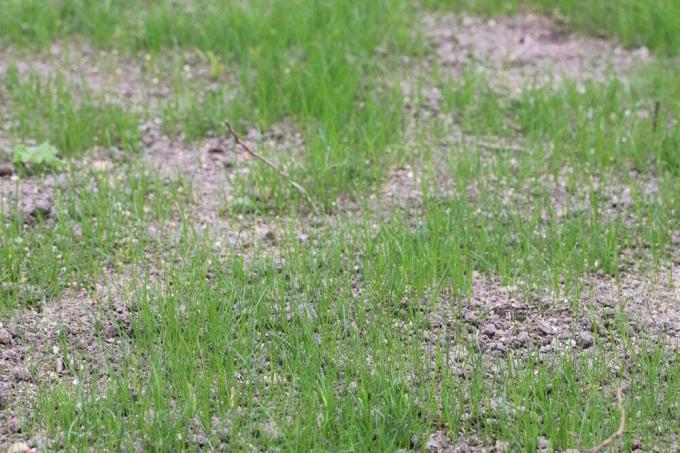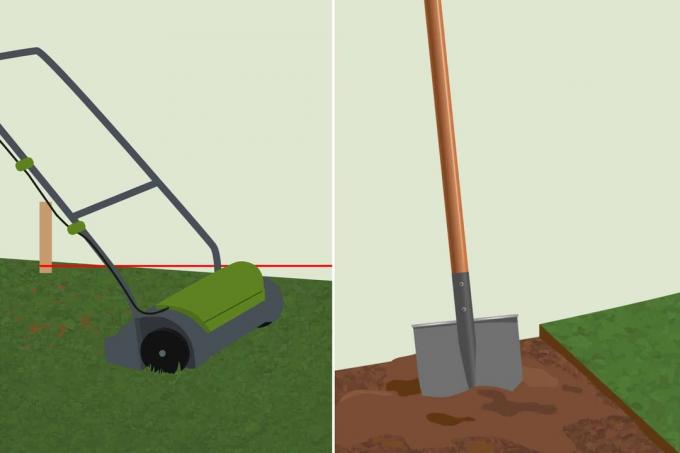

Table of contents
- Brown spots due to lack of care
- Brown discoloration due to fungal attack
- The meadow crane can be to blame
- Interesting facts about brown spots in the lawn - overview
- Tips for pests in the lawn
With knowledge of the cause, however, the brown spots can be easily remedied.
Brown spots due to lack of care
The most common reason for brown spots in the lawn is insufficient maintenance. The unsightly spots can be caused by dehydration - the lawn can burn in direct sunlight and high heat. But waterlogging can also cause stains. This can be remedied by a regular scarification of the lawn, which loosens and aerates it and at the same time ensures that the rainwater can run off well again. In addition, the lawn should be cut regularly, as long blades of grass promote brown discoloration.
Brown discoloration due to fungal attack
Mushrooms in the lawn are widespread and occur primarily where the lawn is permanently damp. There are many different types of fungi, but the red tip is primarily responsible for brown spots in the lawn. The name can cause confusion - the affected lawn does not show red spots, but straw-yellow to brownish spots. The causes of red point are increased moisture in the lawn or stressful situations such as a lack of nutrients, incorrect watering and extremely high temperatures.
The red point does not cause the lawn to die - it just looks extremely unsightly. The brown discoloration of the lawn usually disappears on its own as soon as the moisture balance in the soil is right again. However, if this fungal infestation occurs due to a lack of nutrients, a good lawn fertilizer should be used.
The following methods effectively prevent fungal infestation:
- lawn fertilizer: The lawn should be adequately supplied with nutrients.
- Good ventilation: It is essential to ensure that the lawn is well aerated so that it can grow healthily and beautifully.
- Windbreak: Walls or dense hedges keep the wind out and thus promote the spread of fungi; all leaves should also be removed from the lawn in autumn.
- Water properly: Moisture promotes the growth of fungi in the lawn. A weekly, long watering has a preventive effect here. The water can penetrate deep into the ground while the lawn itself dries quickly.
The meadow crane can be to blame
Spring is here and the lawn is showing brown spots? The larvae of the meadow crane can be to blame. These larvae colonize the area just below the turf, eating up the roots of individual grasses. In the period from August to September, the female crane flies lay their eggs in the lawn, from which the larvae hatch after four to six weeks. These burrow into the turf and usually begin to feast on the grass roots as early as autumn.
In April and May, after the hibernation, the big feeding begins, during which the larvae, which are around four centimeters long, even feed on the leaves of the lawn grass. The grass roots damaged by the larvae cause the lawn to partially turn yellow-brown before it finally dies. The infestation of crane gnats can be distinguished from a fungal disease by the fact that in this If the individual grasses have no deposits or spots, but are uniform discolour.
Even a groundbreaking shows certainty: In the event of an infestation, numerous larvae of the meadow crane fly appear directly under the surface of the soil. The larvae cannot be controlled with insecticides, since insecticides are not approved for eliminating these pests in house gardens and allotments.
Other effective methods are also promising:
- calcium cyanamide: 30 to 40 grams of calcium cyanamide per square meter of lawn can effectively combat the larvae. At the same time, the lawn is supplied with important nutrients. For this purpose, the calcium cyanamide should be scattered as early as the beginning of March, in damp weather.
- Scarify: The larvae of the meadow gnat always stay just below the surface. A low-set scarifier can therefore reduce the population well. Then new lawn seed should be placed in the ground, sprinkled with humus and then rolled.
- SC nematodes: Nematodes can be ordered from garden retailers. These tiny nematodes are placed in water and spread on the lawn in the evening. The SC nematodes penetrate the larvae of the meadow crane fly and infect them with a bacterium. The larvae then die within a few days.
- Collecting the larvae: With a mixture of 1 kg of moist wheat bran and 100 g of sugar, the pests are destroyed after the Animates darkness to leave their subterranean passages - then they can then simply be collected.
Interesting facts about brown spots in the lawn - overview
- Brown spots in the lawn in summer indicate that the lawn has dried up. regular blasting the lawn in the evening hours this helps to prevent drying out in hot phases.
- The sun is then only low in the sky and can no longer cause the blades of grass to burn with the water droplets. If the brown spots despite irrigation remain, it may be because the soil is not absorbing enough water. A wetting agent helps here, which supports the water absorption in the soil.
- The cause of these spots can also be a lack of potassium. Here then is a needs-based and balanced fertilization necessary so that the entire soil structure improves again. A well cared for and fertilized lawn is resistant to all kinds of diseases and also stable to stress caused by drought or frost.
- Regular fertilization of the lawn should also be done regularly without brown spots or other damage.
Tips for pests in the lawn
If the lawn is infested with pests, brown spots can also form. One pest is warbler larva. Whether this pest has infested the lawn is very easy to determine, even for a layperson. You lift off a little from the turf. Since the warbler larva settles directly under the turf, it is very easy to spot. Here it helps to generously remove the ridge infested by the larvae in painstaking detail work and then to sow the lawn again.
If the brown spots in the lawn appear relatively shortly after a fertilization process, there is a possibility that the lawn was burned by the fertiliser. Fertilizers should always be used for fertilizing if the packaging expressly states that the preparation will not burn the lawn.
In addition, the lawn should be watered immediately after the fertilization process - after sunset - so that the fertilizer does not lie on the lawn for too long. If the lawn has turned brown after fertilizing, you can still try to save it by sprinkling the lawn. In the most unfavorable case, however, the lawn must be reseeded in the burned areas.
 garden editorial
garden editorial I write about everything that interests me in my garden.
Learn more about lawn care

Leveling out unevenness in the lawn: this is how it works
Unevenness in the lawn is annoying and poses a danger to gardeners, playing children and pets. There are a number of methods that can be used to level the lawn. We present them to you in our guide.

Leveling the lawn: how to smooth uneven surfaces
Dents and holes in the lawn are unsightly. We will show you step by step how to smooth uneven areas in the lawn again.

Algae in the garden | Lawn is slippery: what to do?
Algae love rainy days. Can the water seep badly into the ground, even better! The green, slippery mass is not only not a pretty sight, but also a danger for the lawn. Only those who act preventively and correctly in acute cases can avoid permanent damage.

Fighting fungi in the lawn | 10 tips against fungal infestation
Mushrooms in the lawn are not uncommon but annoying and sometimes even dangerous. This is especially true if the garden or green space is also used by pets and children. Here we will show you how to combat fungal infestation.

Aerate the lawn | Before or after mowing?
Sun, water, fertilizer and air are necessary for the lawn to grow. If the lawn does not get enough air, it cannot grow properly. We clarify when the right time to ventilate the lawn is.

Mulching with lawn clippings: 13 things to consider
Keeping the lawn short is a must for many hobby gardeners. However, if the lawn mower does not have a mulching function so that the grass clippings can remain on the lawn, the question arises as to where to put the waste. Because the compost heap is not a good solution here.
